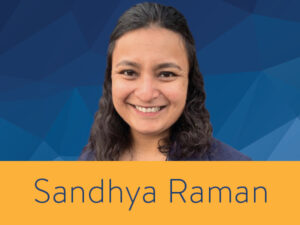November 12, 2020

“I’ve always integrated technology into my teaching — but it is absolutely essential to distance learning success. There are so many outstanding tools available that can help teachers no matter what subjects they teach.”
Sandhya Raman teaches teaches math to 6th though 8th graders.
Making Math Interactive
“I came to MERIT20 with a solid background of using technology in my classroom,” Sandhya tells us, “but the course equipped me with so many new tools as I faced teaching math exclusively through distance learning.”
“For example, Nearpod,” she explains, “is a program that lets me show slides as I talk to my class over the Internet. Each student writes comments or asks questions that I can see in real time.”
Sandhya tallies Nearpod’s benefits in her virtual classroom: she can see who’s engaged and who isn’t, she gets a feeling for what they’re absorbing, and she can answer their questions in real time or after class.
Seeing Familiar Tools in New Ways
There are many tools available, some designed just for education and others we might not consider. “Who doesn’t use Google Maps, or Google Earth?” asks Sandhya. “I’d not thought of them as learning tools, but I’ve now designed a group of math problems based on them.”
Bridging the Distance
Like most teachers, Sandhya notes that finding ways to develop a sense of camaraderie in the distance learning classroom is key to making it work.
It’s harder with younger students, so she employs group activities like creating an online collage. She also uses mindful moments to gauge their feelings and makes sure she gets one-on-one feedback from them each week.
Her older students are more willing to embrace this new way of learning. “We get it!” they tell her, recognizing that school is different now and may be for quite a while. She also crafts assignments based on real-world issues like Covid-19, allowing them to improve research skills plus math problem solving.
Closing Gaps
“I also reach out to parents bi-weekly and let them know what’s been going on,” Sandhya adds. “I make sure to tell them they aren’t responsible for teaching math – that’s my job, not theirs.”
Tools also help her bridge other distance learning gaps. One, for example, lets her verbally provide feedback on work turned in, rather than typing responses. This brings her voice directly to her students and encourages them. These—and many more—were introduced in MERIT20 and broadened her options for online teaching.
We are partnering with school districts to integrate the approach described in these stories with their own professional development programs—however to maintain and expand we need to increase our funding base.
In Summer 2020 alone, we reached over 2000 teachers.
Your support is crucial
Only 10% of our funding comes from the Foothill-De Anza District (primarily for facilities), with another 10% from state lottery funding—the remaining 80% comes from the generous donations of people like you.
Your donation of any amount is gratefully appreciated
You can make a credit card donation on the Foothill Foundation secure donation page*, designating the Krause Center for Innovation as shown below. You will receive an immediate email confirmation of your donation, as well as a hard copy letter.
*KCI is under the fiscal sponsorship of the Foothill-De Anza Community Colleges Foundation, a 501(c)3 auxiliary organization that seeks and sustains philanthropic support for programs that advance student success.
75% of donors contributed $150 or more
Please join them and make California’s teachers more effective and inspiring.



